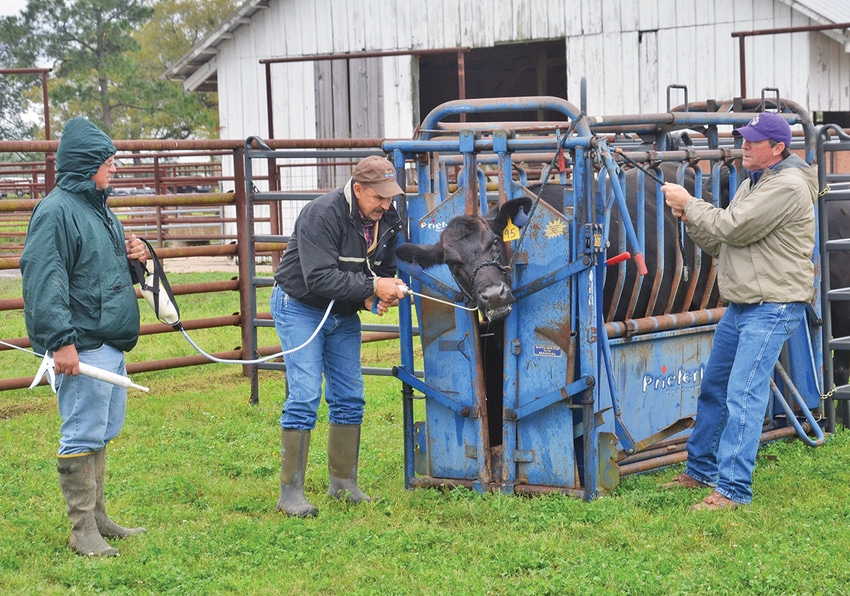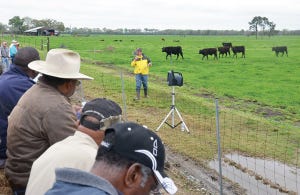April 6, 2016

Antibiotics used for people and also mixed with livestock feed for growth promotion will no longer be allowed by FDA after Jan. 1, 2017, LSU AgCenter veterinarian Christine Navarre told beef producers attending the Acadiana Cattle Producers and LSU AgCenter Iberia Research Station Field Day in March.
The drugs can be used to control, prevent and treat diseases in animals, but they will no longer be available over the counter.
The time before the restriction is in place provides an opportunity to review which drugs are used and whether the use is actually needed or only done out of habit. “You may not need some of these products, and it may save you some money,” Navarre said.

LSU AgCenter ruminant nutritionist Guillermo Scaglia explains his study of stocking rates for Nelson ryegrass and the use of supplements at the Acadiana Cattle Producers and LSU AgCenter Iberia Research Station Field Day on March 19. Photo by Bruce Schultz
Livestock owners will be required to establish formal relationships with veterinarians before prescriptions can be written for the antibiotics. The regulations require a veterinarian have familiarity with a farm or ranch by making regular visits, she said.
Navarre recommended contacting veterinarians now before the new regulations becomes effective.
The new regulations are intended to address the problem of resistant bacteria. In addition, physicians are also addressing this issue for antibiotic use in humans, she said.
Deworming procedures
AgCenter county agents Stuart Gauthier of St. Martin Parish, Stan Dutile of Lafayette Parish, and Andrew Granger of Vermilion Parish, demonstrated deworming procedures, and Navarre showed techniques for administering injections.
The time while cattle are held in a squeeze chute provides a good chance for fecal sampling to determine if dewormers are actually working against parasites. “I am seeing some really severe parasite situations, and I’m seeing adult cattle die,” Navarre said.
Teeth, feet and eyes should also be inspected, she said, as well as checking females for pregnancy.
Needles should be changed for each animal because of the likelihood of transmitting anaplasmosis, a bloodborne disease, Granger said.
All equipment should be ready to use before animals are placed into the chute, Dutile said, and Granger recommended using a halter to restrict sudden head movement.
Nelson ryegrass
AgCenter ruminant nutritionist Guillermo Scaglia gave details of a project to study the effects of stocking rates of steers grazing on Nelson ryegrass. Stocking rates ranged from 1.5 to 2.4 steers per acre.
The optimum stocking rate was 1.8 calves per acre, which allowed 105 grazing days, resulting in 430 pounds of beef per acre with an average daily gain of 2.3 pounds at a cost of 33 cents a pound, Scaglia said.
Another project studying using corn and soybean hulls as feed supplements showed that heifers fed 0.5 percent of their body weight with soybean hulls and grazing on Nelson ryegrass had the highest average daily gain of 2.7 pounds.
AgCenter forage specialist Ed Twidwell said a ton of hay removes 50 pounds of nitrogen, 12 pounds of phosphorous, 50 pounds of potassium and 6 pounds of sulphur from the soil. Fertilizer should be used on hay fields to compensate for the nutrient loss and to promote healthy forage growth that will discourage weeds.
Hay producers should wait until mid-April before applying fertilizer, he said.
AgCenter weed specialist Ron Strahan showed the results of a herbicide study conducted at the station. The herbicide Prowl H20 is a good pre-emergence herbicide for small-seeded broadleaves and annual grasses in hay meadows, he said. Pastora gave the best postemergence control of winter broadleaf weeds and grasses in the trial.
Also at the field day, 45 graduates of the Louisiana Master Cattleman Program were recognized for completing the comprehensive 10-week course.
Dutile said the next Master Cattleman class will be held in 2017.
Smartphone apps
Stuart Gauthier, AgCenter county agent in St. Martin Parish, reviewed several smartphone apps for cattle, including a Mississippi State University calculator to determine calving dates and a University of Nebraska body condition scoring aid.
Blair Hebert, AgCenter county agent in Iberia Parish, detailed interpretation of soil test results, and Allen Hogan with the AgCenter Master Farmer Program explained the goals and benefits of participating in the program.
Iberia Research Station director Eric Webster said work at the station involves more than cattle. Wheat and soybean variety trials, sugarcane variety development, biofuels research, a cover crop study and air quality research are also being done this year at the station.
Webster said the station’s economic impact will be realized from the field day. “You’re going to go back to your farm today with something that’s going to help you make money.”
Phil Elzer, AgCenter associate vice president, said the AgCenter is likely to have its budget cut again for the current fiscal year and the next year. “We’re already short 4-H agents, county agents and faculty,” he said.
Christine Navarre can be reached at (225) 578-3241 or [email protected]
Guillermo Scaglia can be reached at (337) 276-5527 or [email protected]
You May Also Like




